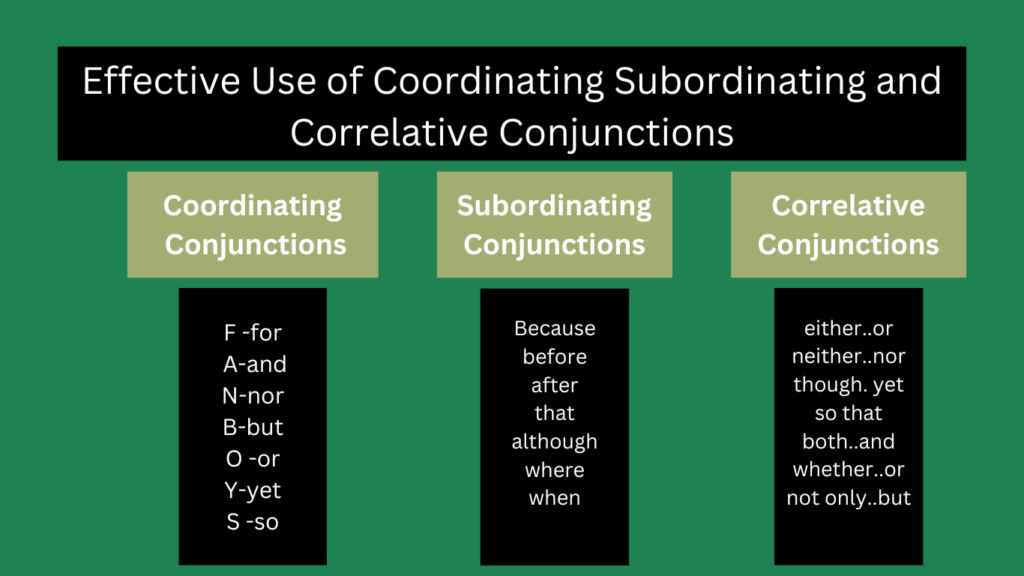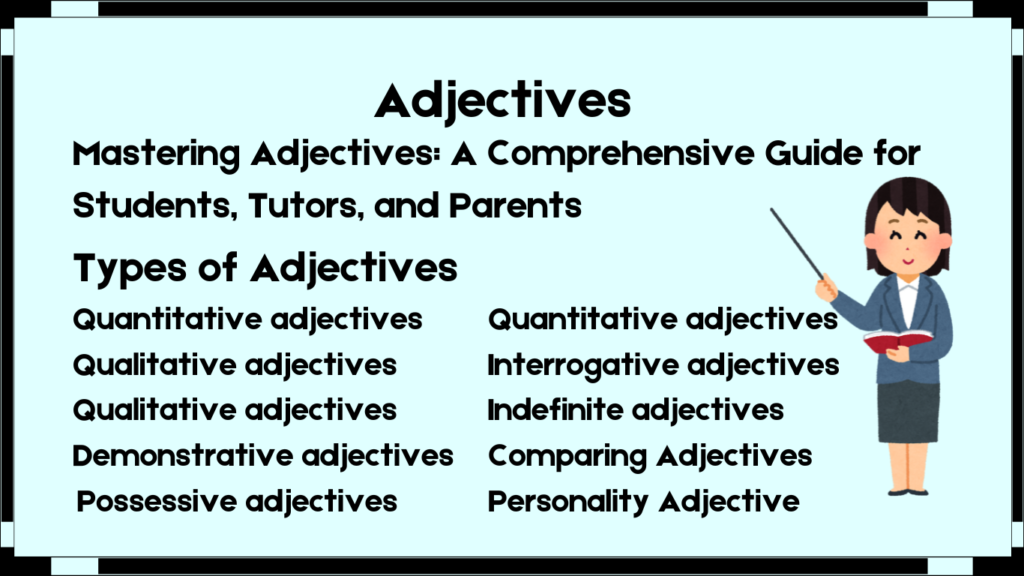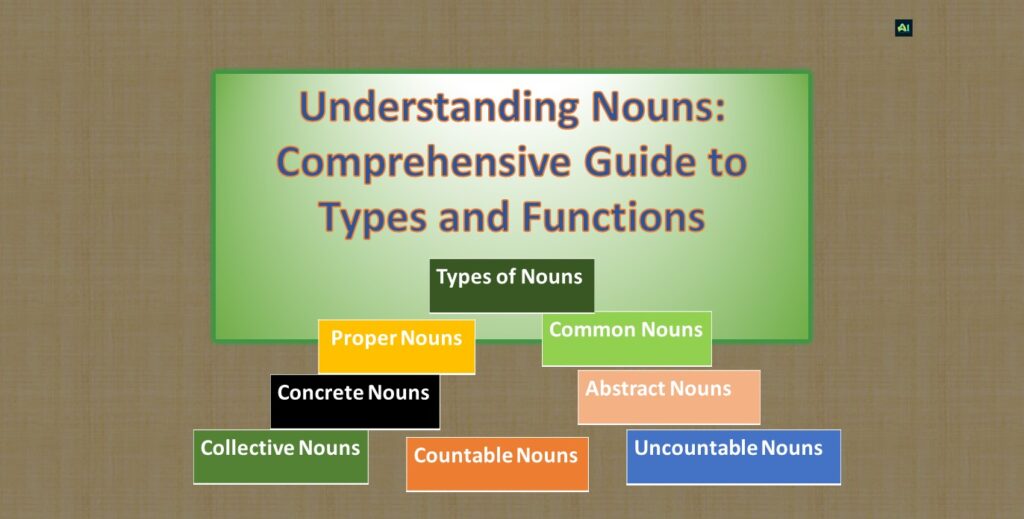A Guide to Effective Use of Coordinating Subordinating and Correlative Conjunctions
Introduction
Conjunctions are words that join words phrases and clauses in English sentences. They are helpful in creating complex and compound sentences, making the language flow smoothly. Effective Use of Coordinating Subordinating and Correlative Conjunctions is crucial for anyone aiming to improve their English writing and speaking skills. In this post We will explore these three main types of conjunction.
1. Coordinating Conjunctions
Coordinating conjunctions connect words, phrases, or independent clauses of equal importance. The most common coordinating conjunctions are: and, but, or, nor, for, so, and yet.
1.1 Coordinating conjunctions connecting words
Here are some examples of conjunctions that connect words:
- And: Connects similar ideas or items.
- She likes coffee and tea.
- Or: Presents alternatives or choices.
- Would you like pizza or pasta?
- But: Indicates contrast between ideas.
- He is tall but shy.
- Nor: Used to connect negative ideas.
- She doesn’t like fish, nor does she like meat.
- Yet: Adds contrasting information.
- The movie was boring, yet she watched it till the end.
- So: Indicates a result or effect.
- It was raining, so we stayed indoors.
1.2 Coordinating conjunctions connecting Phrases
Here are some examples of coordinating conjunctions connecting phrases:
- And: Connects two similar ideas or phrases.
- She enjoys reading books and listening to music.
- Or: Offers alternative choices or options.
- You can study now or wait until after dinner.
- But: Introduces a contrast between two phrases.
- He wanted to buy a new phone, but he decided to save money instead.
- Nor: Connects two negative phrases.
- He doesn’t like doing homework, nor does he enjoy studying for exams.
- For: Explains a reason for something.
- She decided to leave early, for she had an important meeting.
- Yet: Adds a contrasting idea to the first phrase.
- The day was hot, yet she wore a jacket.
- So: Indicates a consequence or result.
- He forgot to set his alarm, so he was late for class.
1.3 Coordinating conjunctions connecting words
Here are some examples of coordinating conjunctions connecting independent clauses:
- And: Adds related or additional information.
- She loves to travel, and she often visits new places.
- But: Shows a contrast between two clauses.
- I wanted to go to the party, but I had to finish my assignment.
- Or: Presents alternatives or choices.
- You can join us for dinner, or you can meet us later.
- Nor: Connects two negative independent clauses.
- He doesn’t like watching TV, nor does he enjoy playing video games.
- For: Provides a reason or explanation.
- She left early, for she wasn’t feeling well.
- Yet: Indicates a surprising contrast or exception.
- He trained very hard, yet he didn’t win the race.
- So: Shows a result or consequence.
- The weather was terrible, so we decided to stay indoors.
1.4 How to Use Coordinating Conjunctions Effectively
Coordinating conjunctions are the simplest type to use, but they require careful attention to sentence structure. Use them to join two independent clauses, ensuring each clause can stand alone as a complete sentence.
2. Subordinating Conjunctions
Subordinating conjunctions are used to connect an independent clause with a dependent clause, indicating a relationship such as cause, time, or condition. Common subordinating conjunctions include: because, although, since, if, when, while, after, that, after, etc.
ere are some examples of sentences using subordinating conjunctions to connect an independent clause with a dependent clause:
- Because:
- She was late to the meeting because her car broke down.
- Although:
- Although it was raining, they continued their hike.
- Since:
- Since he started exercising regularly, he has felt much healthier.
- If:
- You can go out to play if you finish your homework.
- When:
- I always feel happy when I listen to my favorite music.
- While:
- While he was cooking dinner, she set the table.
2.1 Classification of Subordinating Conjunctions
Subordinating conjunctions are divided into seven classes based on their function in a sentence. These classes include time, place, cause, condition, concession, comparison, and purpose.
1. Time Subordinating Conjunctions
These conjunctions indicate the time relationship between two clauses.
Examples: before, after, till, since, when, while.
- We should leave before it gets dark.
- She has been working here since she graduated.
- They waited till the store opened.
2. Place Subordinating Conjunctions
These conjunctions indicate the place where the action of the main clause happens.
Examples: where, wherever.
- You can sit wherever you like.
- I will meet you where we had lunch yesterday.
3. Cause Subordinating Conjunctions
These conjunctions show the reason or cause for the action in the main clause.
Examples: because, as, since.
- He stayed home because he was feeling sick.
- Since it’s raining, we will cancel the picnic.
4. Condition Subordinating Conjunctions
These conjunctions introduce a condition under which the action of the main clause will happen.
Examples: if, unless, provided that.
- You can borrow my car if you return it by tomorrow.
- We will succeed unless we give up.
5. Concession Subordinating Conjunctions
These conjunctions show contrast or unexpected results in relation to the main clause.
Examples: although, though, even though.
- She went for a walk although it was snowing.
- Even though he was tired, he continued to work.
6. Comparison Subordinating Conjunctions
These conjunctions are used to compare the action or state in the dependent clause to that in the main clause.
Examples: than, as, as though.
- She is taller than her brother.
- He speaks as if he knows everything.
7. Purpose Subordinating Conjunctions
These conjunctions show the purpose of the action in the main clause.
Examples: so that, in order that.
- She studied hard so that she could pass the exam.
- He left early in order that he could catch the first train.
3. Correlative Conjunctions: Balancing Sentence Elements
Correlative conjunctions are used in pairs to connect equal elements in a sentence, ensuring balance and clarity. Below are examples for each pair:
- Either…or
- You can either come with us or stay at home.
- She will either study medicine or become a lawyer.
- Neither…nor
- He is neither interested in sports nor in music.
- They neither want to travel nor move to a new city.
- Both…and
- She is both an excellent writer and a skilled speaker.
- The project requires both time and effort.
- Whether…or
- I don’t know whether to call him or wait for his message.
- She couldn’t decide whether to buy the red dress or the blue one.
- Though…yet
- Though it was challenging, yet he managed to complete the project.
- Though she is young, yet she has a lot of experience.
- Not only…but also
- He is not only smart but also hardworking.
- The restaurant serves not only delicious food but also provides great service.
- So that
- He moved to the city so that he could find a better job.
- They practiced regularly so that they could win the competition.
- No sooner…than
- No sooner had we started eating than the phone rang.
- No sooner did she finish the book than she began another.
5. Common Mistakes with Coordinating Subordinating and Correlative Conjunctions and How to Avoid Them
Many English learners and even native speakers make mistakes with conjunctions. Common errors include:
- Overusing conjunctions: Avoid using too many conjunctions in a single sentence.
- Comma splices: Do not use a comma alone to connect two independent clauses. Use a coordinating conjunction or a semicolon.
- Incorrect pairs: Ensure correlative conjunctions are used in matching pairs.
6. Tips for Mastering Coordinating Subordinating and Correlative Conjunctions in English
- Practice regularly: Write sentences using different types of conjunctions.
- Read extensively: Pay attention to how conjunctions are used in books, articles, and other materials.
- Use a thesaurus: Explore synonyms for common conjunctions to diversify your vocabulary.
Conclusion: Enhancing Your English with Conjunctions
Effective Use of Coordinating Subordinating and Correlative Conjunctions improve your English fluency and writing skills. By understanding and correctly using coordinating, subordinating, and correlative conjunctions, you can create more complex and nuanced sentences. Keep practicing, and soon you’ll find using conjunctions becomes second nature.



